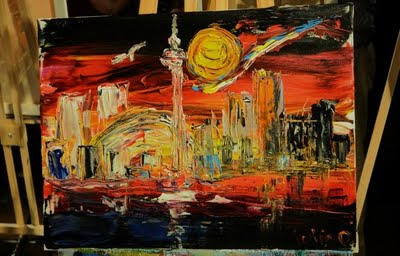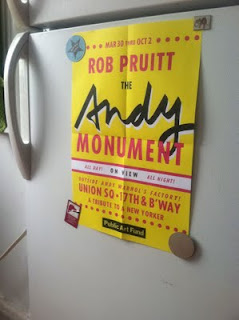Art Battle is many things: dramatic, thought-provoking, theatrical, joyous, challenging, surreal. It’s also a great place to see the work of emerging artists.
My eye was recently caught at the last Art Battle by Iulia Olar, a Romanian-born, Toronto-based artist who was participating. Her gorgeous, vibrant cityscapes were joyously retina-ripping, and I felt honored to be witnessing the creation of not one but two beautiful renderings of Toronto’s skyline.
The way Iulia paints – a mix of focus, intuition, feeling and detail -reflects a deeply poetic sense of both her environment and the people in it. Her dance between brushes and palette knives, wielding one, then the other, with a seamless integration of head and heart, smuding here, dabbing there, was a magical thing, akin to the spinning tango dancers I’d see Sundays in Union Square. As with so many arts, either a person has a gift to develop, or they don’t. Learning the steps, mixing the colors -they take practise, of course -but it’s up to the individual to properly use those energies, with a mix of pinpoint precision and passionate abandon. Iulia does both.
So it was an honor to have this Q&A with her, and to learn more about someone whose talent is bursting with the living of life, moment by moment, stroke by stroke.
How did you first get interested in painting?
I came to Canada as a poet, with three books in my luggage. After three years I realized that I wouldn’t be able to write anymore, so I decided to express myself through painting.I started to paint on September 19th, 2009: I went to the store, bought canvases, paints, brushes, and took books from the library… and here I am! I have to admit, I took one year of drawing lessons -that was a long time ago -but never, ever did I paint. I want to remain for as long as possible a self-taught artist. It’s so natural and much less stressful.
I also have a wonderful husband, a wonderful son and a wonderful friend. They encouraged me from the first moment. Terry Mardini (my friend) bought over forty paintings -and she exhibited them in her apartment. What a friend! I am very lucky.
Believe me or not, every time I sell a painting I say :”Forgive me, Vincent!” (Vincent Van Gogh). That’s my story with painting . You know, I see myself doing this for the rest of my life.
How does being involved in Art Battle help your artistic development?
I consider participation at Art Battle a unique experience that every painter should have. You can test yourself and the public’s reaction towards your art, right on the spot. There, you have to give your best in twenty minutes. Leonardo Da Vinci spent seven years giving us the Mona Lisa -and only a few rich people benefit from that type of art. It’s not possible (to work that way) anymore. The modern artist has to be there for the people, right away -there is no time to wait.
Who are some of your favorite painters and why?
I adore Vincent Van Gogh. He felt that is nothing more truly artistic than to love people. Because he risked his health and his life for his work: “I put my heart and my soul into my work, and have lost my mind in the process.” Because he sold one (one!) painting in his entire life but, this, couldn’t stop him from painting. What an artist!
Why acrylic paint? Would you consider other media?
I like acrylic because it’s an extremely liberating medium. Its versatility is actually its best quality; use it like oil paint, watercolour or gouache. Acrylics gained my favour because they offer many advantages: great colour, a fastness that doesn’t fade or yellow or harden with age (or crack), it dries much faster then oil paint too, so it’s great for studio work. I use more acrylic paint because I don’t feel like considering other media… but who knows? Maybe in the future.
You seem to do a lot of cityscapes; what’s the attraction, creatively?
As an artist, you must learn to trust your own feelings, judgment and analysis about what you like and why. Ambivalence in your approach will lead to an ambivalence response from the viewer. You don’t have to please all the people by somehow finding the average line.
Yes, I can say, Toronto’s skyline attracts me because of that insolent CN tower that lances my sky. Sky bleeds, suffers. People stay at home. Nobody to be seen on the streets. The water: second reality, refuses to capture the mirror image, makes another one more subtle.
This theme reveals my love and my hate, my choleric side. A solitary seagull flies -the guardian of the city. The strong colors I use add life and dynamic they are projections of the people not of the town itself. I also paint flowers, landscapes, family members when I am in the “quiet mood”
What’s next in terms of your work and where can we see it?
I have plans to create a website where I’ll post all my work and keep in touch with friends, and try to participate as much as I can in public events, art galleries, etc. This is a never-ending story for me and I feel very engaged with every single detail. I start to count my life in days that I paint well. Who knows one day I’ll have my own studio, students and I will make my art my entire occupation.



